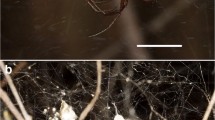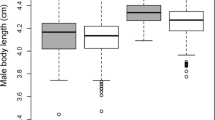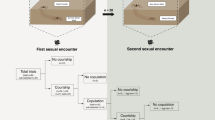Abstract
Males should be more selective when they have a high investment in reproduction, especially in species with biparental or paternal care. In this context, male mate choice can promote size-assortative mating (SAM) when (1) large males win intrasexual disputes, (2) large females are more fecund, and (3) males prefer larger females to smaller ones. In the spider Manogea porracea, males exhibit high reproductive investment by building their webs above those of females and exhibiting extended care of offspring in the absence of females. Under these circumstances, we expect the occurrence of SAM and male preference for large females. Herein, we performed observations and experiments in the field to evaluate the hypotheses that (1) M. porracea mates assortatively by size and (2) SAM is influenced by male mate choice. Furthermore, we measured variables that could affect mating patterns, the sex ratios, and densities of both sexes. Pairing in M. porracea was positively size-assortative in 2012, but not in 2013. Large males won most disputes for mates and preferred larger females, which produced more eggs. The inconsistency in detection of SAM was due to population dynamics, namely variations in sex ratio and population density across the breeding season. Furthermore, we found that the significance of male mate choice on sexual selection of body size in M. porracea strongly depends on the competition intensity for mating opportunities. The traditional sexual selection hypothesis of SAM needs to be reviewed and must include measures of competition intensity.






Similar content being viewed by others
References
Adams J, Greenwood P, Pollitt R, Yonow T (1985) Loading constraints and sexual size dimorphism in Asellus aquaticus. Behaviour 3(4):277–287
Anderson M (1994) Sexual selection. Princeton University Press, New Jersey
Arak A (1983) Male–male competition and male choice in anuran amphibians. In: Bateson P (ed) Mate choice. Cambridge University Press, Cambridge, pp 181–210
Arnqvist G, Rowe L, Krupa JJ, Sih A (1996) Assortative mating by size: a meta-analysis of mating patterns in water striders. Evol Ecol 10:265–284
Arntzen JW (1999) Sexual selection and male mate choice in the common toad, Bufo bufo. Ethol Ecol Evol 11:407–414
Barry KL, Kokko H (2010) Male mate choice: why sequential choice can make its evolution difficult. Anim Behav 80:163–169
Bel-Venner MC, Dray S, Allainé D, Menu F, Venner S (2008) Unexpected male choosiness for mates in a spider. P Roy Soc Lond B Bio 275:77–82
Birkhead TR, Clarkson K (1980) Mate selection and precopulatory guarding in Gammarus pulex. Ethology 52:365–380
Boag PT (1983) The heritability of external morphology in Darwin’s ground finches (Geospiza) on Isla Daphne Major, Galapagos. Evolution 37:877–894
Bortolotti GR, González LM, Margalida A, Sánchez R, Oria J (2008) Positive assortative pairing by plumage colour in Spanish imperial eagles. Behav Process 78:100–107
Brown WD (1993) The cause of size-assortative mating in the leaf beetle Trirhabda canadensis (Coleoptera: Chrysomelidae). Behav Ecol Sociobiol 33:151–157
Burley N (1983) The meaning of assortative mating. Ethol Sociobiol 4:191–203
Cézilly F, Boy V, Tourenq CJ, Johnson AR (1997) Age-assortative pairing in the greater flamingo Phoenicopterus ruber roseus. Ibis 139:331–336
Christenson TE (1984) Alternative reproductive tactics in spiders. Am Zool 24:321–332
Clutton-Brock TH (2007) Sexual selection in males and females. Science 318:1882–1885
Crespi BJ (1989a) Causes of assortative mating in arthropods. Anim Behav 38:980–1000
Crespi BJ (1989b) Sexual selection and assortative mating in subdivided populations of the thrips Elaphrothrips tubercufatus (Insecta: Thysanoptera). Ethology 83:265–278
Dickerson BR, Willson MF, Bentzen P, Quinn TP (2004) Size-assortative mating in salmonids: negative evidence for pink salmon in natural conditions. Anim Behav 68(2):381–385
Dodson G, Marshall L (1984) Mating patterns in an ambush bug Phymata fasciata (Phymatidae). Amer Midl Nat 112:50–57
Eberhard WG (1996) Female control: sexual selection by cryptic female choice. Monographs in behavior and ecology. Princeton University Press, New Jersey
Edward DA, Chapman T (2011) The evolution and significance of male mate choice. Trends Ecol Evol 26:647–654
Emlen ST, Oring LW (1977) Ecology, sexual selection, and the evolution of mating systems. Science 197:215–223
Erlandsson J, Rolán-Alvarez E (1998) Sexual selection and assortative mating by size and their roles in the maintenance of a polymorphism in Swedish Littorina saxatilis populations. Hydrobiologia 378:59–69
Foellmer MW, Moya-Larano J (2007) Sexual size dimorphism in spiders: patterns and processes. In: Fairbairn DJ, Blanckenhorn WU, Szekely T (eds) Sex, size, and gender roles: evolutionary studies of sexual size dimorphism. Oxford University Press, New York, pp 71–81
Frey D, Leong KL, Peffer E, Smidt RK, Oberhauser K (1998) Mate pairing patterns of monarch butterflies (Danaus plexippus L.) at a California overwintering site. J Lep Soc 52:84–97
Gade MR, Hill M, Saporito RA (2016) Color assortative mating in a mainland population of the poison frog Oophaga pumilio. Ethology 122:1–8
Gutiérrez G, Lüddecke H (2002) Mating pattern and hatching success in a population of the Andean frog Hyla labialis. Amphibia-Reptilia 23:281–292
Harari AR, Handler AM, Landolt PJ (1999) Size assortative mating, male choice and female choice in the curculionid beetle Diaprepes abbreviatus. Anim Behav 58:1191–1200
Härdling R, Kokko H (2005) The evolution of prudent choice. Evol Ecol Res 7:697–715
Harris MR, Siefferman L (2014) Interspecific competition influences fitness benefits of assortative mating for territorial aggression in eastern bluebirds (Sialia sialis). PLoS One 9:e88668
Hoefler DC (2007) Male mate choice and size-assortative pairing in a jumping spider, Phidippus clarus. Anim Behav 73:943–954
Honěk A (1993) Intraspecific variation in body size and fecundity in insects: a general relationship. Oikos 66:483–492
Jiang Y, Bolnick DI, Kirkpatric M (2013) Assortative mating in animals. Am Nat 181:e125–e138
Johannesson K, Rolan-Alvarez E, Ekendahl A (1995) Incipient reproductive isolation between two sympatric morphs of the intertidal snail Littorina saxatilis. Evolution 49:1180–1190
Johnstone RA, Reynolds JD, Deutsch JC (1996) Mutual mate choice and sex differences in choosiness. Evolution 50:1382–1391
Jones AG, Moore GI, Kvarnemo C, Walker D, Avise JC (2003) Sympatric speciation as a consequence of male pregnancy in seahorses. Proc Natl Acad Sci U S A 100:6598–6603
Kirkpatrick M, Ravigné V (2002) Speciation by natural and sexual selection: models and experiments. Am Nat 159:S22–S35
Klug H, Heuschele J, Jennions MD, Kokko H (2010) The mismeasurement of sexual selection. J Evol Biol 33:447–462
Kokko H, Johnstone RA (2002) Why is mutual mate choice not the norm? Operational sex ratios, sex roles and the evolution of sexually dimorphic and monomorphic signalling. Philos Trans R Soc B 357:319–330
Kokko H, Rankin DJ (2006) Lonely hearts or sex in the city? Density-dependent effects in mating systems. Philos Trans R Soc B 361:319–334
Kondrashov AS, Shpak M (1998) On the origin of species by means of assortative mating. P Roy Soc Lond B Bio 265:2273–2278
Kralj-Fišer S, Mostajo GAS, Preik O, Pekár S, Schneiderb JM (2013) Assortative mating by aggressiveness type in orb weaving spiders. Behav Ecol 24:824–831
Kvarnemo C, Simmons LW (1998) Male potential reproductive rate influences mate choice in a bushcricket. Anim Behav 55:1499–1506
Levi HW (1997) The American orb weavers of the genera Mecynogea, Manogea, Kapogea and Cyrtophora (Araneae: Araneidae). Bull Mus Comp Zool 155:215–255
Masumoto T (1999) Size assortative mating and reproductive success of the funnel-web spider, Agelena limbata (Araneae; Agelenidae). J Insect Behav 12:353–361
McLain DK (1982) Behavioral and morphological correlates of male dominance and courtship persistence in the blister beetle Epicauta pennsylvanica (Coleoptera: Meloidae). Am Midl Nat 107:396–403
McLain DK, Boromisa RD (1987a) Male choice, fighting ability, assortative mating and the intensity of sexual selection in the milkweed longhorn beetle, Tetraopes tetraophthalmus (Coleoptera, Cerambycidae). Behav Ecol Sociobiol 20:239–246
McLain DK, Boromisa RD (1987b) Stabilizing sexual selection and density-dependent correlates of copulatory success in the ambush bug, Phymata wolffii (Hemiptera: Reduviidae). Am Midl Nat 117:94–102
Michiels NK, Hohner A, Vorndran IC (2001) Precopulatory mate assessment in relation to body size in the earthworm Lumbricus terrestris: avoidance of dangerous liaisons? Behav Ecol 12:612–618
Miyashita T (1994) Size-related mating and mate guarding in the orb-web spider Nephila clavata (Araneae, Araneidae). J Insect Behav 7:289–296
Mobley KB, Abou Chakra M, Jones AG (2014) No evidence for size-assortative mating in the wild despite mutual mate choice in sex-role-reversed pipefishes. Ecol Evol 4:67–78
Moura RR, Peixoto PEC (2013) The effect of operational sex ratio on the opportunity for sexual selection: a meta-analysis. Anim Behav 86:675–683
Moura RR, Vasconcellos-Neto J, Gonzaga MO (2017) Extended male care in Manogea porracea (Araneae: Araneidae): the exceptional case of a spider with amphisexual care. Anim Behav 123:1–9
Ólafsdóttir GÁ, Ritchie MG, Snorrason SS (2006) Positive assortative mating between recently described sympatric morphs of Icelandic sticklebacks. Biol Lett 2:250–252
Parker GA (2006) Sexual conflict over mating and fertilization: an overview. Philos Trans R Soc B 361:235–259
Prenter J, MacNeil C, Elwood RW (2006) Sexual cannibalism and mate choice. Anim Behav 71:481–490
Pruitt JN, Riechert SE (2009) Male mating preference is associated with risk of pre-copulatory cannibalism in a socially polymorphic spider. Behav Ecol Sociobiol 63:1573–1580
Ridley M (1983) The explanation of organic diversity: the comparative method and adaptations for mating. Clarendon Press, Oxford
Ritchie MG (2007) Sexual selection and speciation. Annu Rev Ecol Evol Syst 38:79–102
Rittschof CC (2010) Male density affects large-male advantage in the golden silk spider, Nephila clavipes. Behav Ecol 21:979–985
Robertson JG (1990) Female choice increases fertilization success in the Australian frog, Uperoleia laevigata. Anim Behav 39:639–645
Rubenstein DI (1987) Alternative reproductive tactics in the spider Meta segmentata. Behav Ecol Sociobiol 20:229–237
Schulte KF, Uhl G, Schneider JM (2010) Mate choice in males with one-shot genitalia: limited importance of female fecundity. Anim Behav 80:699–706
Seehausen O, Van Alphen JJ, Witte F (1997) Cichlid fish diversity threatened by eutrophication that curbs sexual selection. Science 277:1808–1811
Taborsky B, Guyer L, Demus P (2014) ‘Prudent habitat choice’: a novel mechanism of size-assortative mating. J Evol Biol 27:1217–1228
Thomas F, Oget E, Gente P, Desmots D, Renaud F (1999) Assortative pairing with respect to parasite load in the beetle Timarcha maritima (Chrysomelidae). J Evol Biol 12:385–390
Venner S, Bernstein C, Dray S, Bel-Venner MC (2010) Make love not war: when should less competitive males choose low-quality but defendable females? Am Nat 175:650–661
Vieira MC, Peixoto PE (2013) Winners and losers: a meta-analysis of functional determinants of fighting ability in arthropod contests. Funct Ecol 27:305–313
Wong BBM, Jennions MD (2003) Costs influence male mate choice in a freshwater fish. Proc R Soc B 270:S36–S38
World Spider Catalog (2017). World Spider Catalog. Natural History Museum Bern, online at http://wsc.nmbe.ch, version 17.5, accessed on December 1, 2016.
Zimmer SM, Schneider JM, Herberstein ME (2014) Can males detect the strength of sperm competition and presence of genital plugs during mate choice? Behav Ecol 25:716–722
Acknowledgements
We thank Duratex S.A. for allowing our work in Fazenda Nova Monte Carmelo, Giancarlo Ângelo Ferreira, and Yuri Lima Vasconcelos Ferreira for providing transport to the study area in several occasions and Paulo Enrique C. Peixoto for suggestions on an initial draft of this manuscript. We also thank Sven Thatje, Simona Kralj-Fišer, and another anonymous reviewer for their contribution to improvement of the text. This project was supported by Coordenação de Aperfeiçoamento de Pessoal de Nível Superior (research grant to R.R.M.), Instituto Nacional de Ciência e Tecnologia dos Hymenoptera Parasitoides da Região Sudeste (HYMPAR/Sudeste - CNPq/CAPES/Fapesp), Fundação de Amparo à Pesquisa de Minas Gerais (Proc. APQ-02104-14, CRA-30058/12, APQ-03202-13; APQ-02474-15), and Conselho Nacional de Desenvolvimento Científico e Tecnológico (Proc. 306157/2014-4; 403733/2012-0; 445832/2014-2). Voucher specimens of Manogea porracea were deposited in the collection of Universidade Federal de Minas Gerais (curator A. J. Santos), Minas Gerais, Brazil.
Author information
Authors and Affiliations
Corresponding author
Additional information
Communicated by: Stano Pekar
Rights and permissions
About this article
Cite this article
Moura, R.R., Gonzaga, M.O. Temporal variation in size-assortative mating and male mate choice in a spider with amphisexual care. Sci Nat 104, 28 (2017). https://doi.org/10.1007/s00114-017-1448-6
Received:
Revised:
Accepted:
Published:
DOI: https://doi.org/10.1007/s00114-017-1448-6




